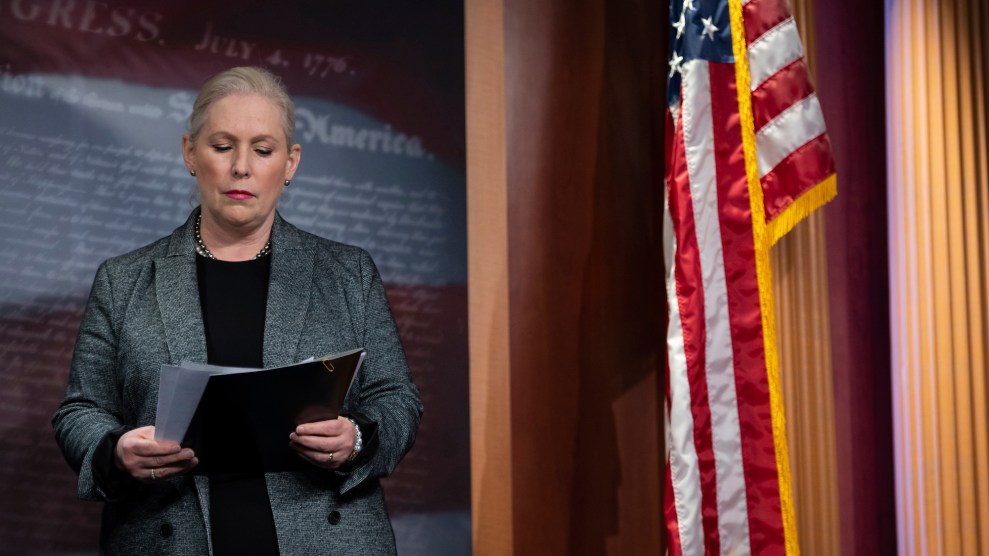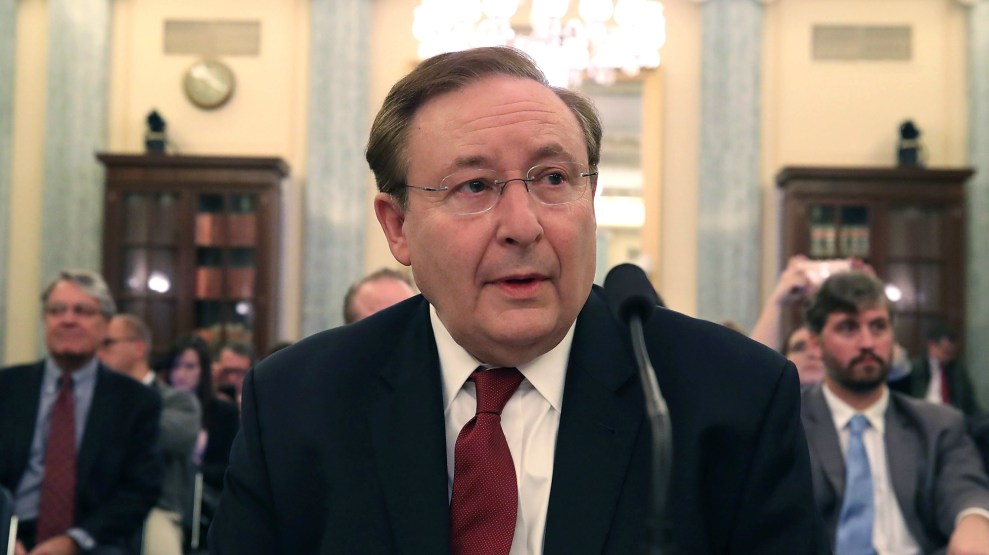
The fieldwork camp at Allan Hills, Antarctica, where researchers drill ice cores, December 2022.Peter Neff/COLDEX
This story was originally published by Undark and is reproduced here as part of the Climate Desk collaboration.
In September 2022, two months before PhD student Megan Kerr was scheduled to board a military plane bound for the Antarctic ice sheet, she found herself in a conference room on Oregon State University’s campus, waiting to ask a question that had been nagging her for weeks. She sat intently through a presentation from the National Science Foundation Office of Polar Programs. Then, she raised her hand. The room full of graduate students turned in their chairs.
“This NSF report about all the sexual harassment that’s going on in the field,” she said. “What is the NSF going to be doing in the short term, also long term, about that?” Because “a lot of us are going into the field in like, two months.”
These students and about a hundred other researchers from roughly a dozen institutions had gathered at Oregon State University to kick off COLDEX, a 5-year, $25-million-dollar paleoclimatology project tasked by the NSF, the federal science agency, to find and drill a core of Earth’s oldest ice in Antarctica.
The report Kerr mentioned was the 273-page elephant in the room—a document the NSF released in late August detailing a decades-long history of pervasive sexual harassment and assault at Antarctic research stations. Almost three-quarters of women surveyed agreed that harassment was a problem, describing it as a “fact of life” on the continent. And 95 percent of women interviewed in focus groups knew someone who had experienced assault or harassment within the Antarctic program. To outsiders, the graphic detail and matter-of-fact descriptions were shocking. But in the polar science community, the reaction was different.
When the report came out, “No one was surprised, other than the grad students.” Kerr said. She spoke with her principal investigators and supervisors, “and they were like, ‘Yeah, it’s been an issue for a long time.’ Okay, why is this the first time I’m hearing about it?”
Since middle school, Kerr wanted to go to Antarctica. This most recent field season, which typically takes place over the Austral summer, from mid-October to mid-February, she had finally been chosen as part of an eight-person COLDEX team to survey the ice sheet at Antarctica’s remote South Pole. She was one of two graduate students, and the only woman, on her team.
“It sucked because I was so excited for it, you know?” Kerr said. “This is a thing I wanted for years and years. And finally I got to do it, I’m getting to do it, and then I hear that oh, actually, it’s a terrible place to work if you’re a woman.”
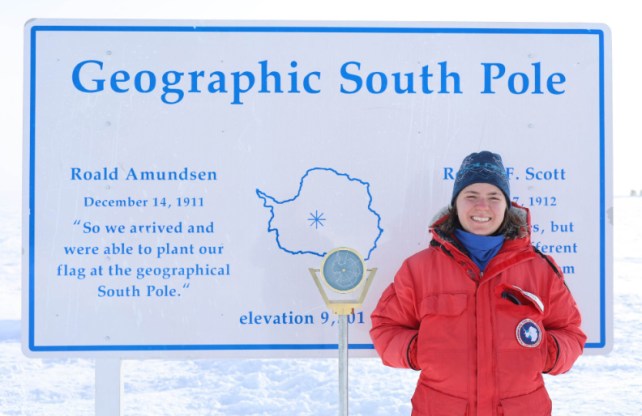
Doctoral student Megan Kerr traveled to the South Pole this field season as a member of a COLDEX team. Prior to her departure, an NSF report on sexual harassment in the polar sciences took her by surprise.
Courtesy Megan Kerr
COLDEX leadership think their initiative, with its unprecedented funding, unusually long timescale, and built-in commitment to diversify the polar sciences, could bring some change. But Kerr and her fellow graduate students worry the NSF response to a systemic, deeply entrenched culture problem has been surface-level. They are also left wondering what the field’s path forward looks like.
Erin Pettit is an experienced polar researcher and COLDEX’s director of diversity, equity, and inclusion. Originally, her role was to guide the center in its mandate to recruit a more diverse team of researchers. But now, she’s also responsible for COLDEX’s response to the bombshell NSF report. To her, those goals are closely linked. “Our biggest challenge actually stems from the fact that polar science started from White, male, Northern European explorations,” said Pettit. “And it is still very White and mostly male.”
This history is part of Antarctica’s hero factor, according to sociologist Meredith Nash, who studies gender in polar science at the Australian National University—a pervasive image of a polar scientist as a bearded, White, male, able-bodied hero “battling against the blizzard” and penetrating the final icy terra incognita. Polar science started with the risky adventures of men like Robert Falcon Scott and Ernest Shackleton, and those stories have enduring power: Polar scientists joke their field remains “pale and male.”
“That narrative of the hero, climber, science hero, whatever you want to call it, that attitude comes along often with this attitude that they are in a powerful position and can take advantage of that power,” said Pettit. “Often people will use that sense of power to hurt people who are in vulnerable positions.”
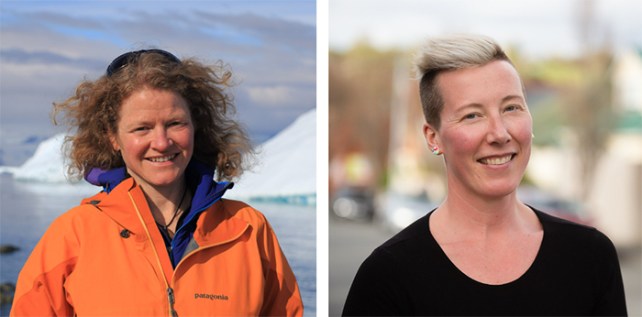
From left: Erin Pettit, COLDEX’s director of diversity, equity, and inclusion; and sociologist Meredith Nash.
Courtesy of Erin Pettit and Eric Byler/ANU
In 1957, after the United States established its first permanent bases on the continent, the then-program supervisor joked, “women will not be allowed in the Antarctic until we can provide one woman for every man,” according to a history of the base. It wasn’t until 1969 that the first all-women scientific team deployed to Antarctica. At the time, a New York Times reporter called it “an incursion” into the “largest male sanctuary remaining on this planet.”
Women were excluded as not physically able to work in the extreme environment and as distractions for men. National Antarctic programs in the US, United Kingdom, and Australia only allowed women to conduct fieldwork sporadically prior to the 1980s. These women entered a world built for men—one lacking gender-specific facilities or gear in the right sizes. At Australia’s polar station, a collage of nearly a hundred pornographic pinups covered the ceiling.
“All of this energy on stations has been to tell women directly they’re not wanted here,” said Nash. “The bullying, the harassment, the male joking culture—it’s a very clear message that women shouldn’t be there.”
Pettit has been to Antarctica for 21 expeditions, starting in the late ‘90s as a graduate student. “I’ve definitely been that one woman on a field team who ended up cooking every single night,” she said. It wasn’t every time, because she largely had good team leaders, but “that was definitely my role for no other reason than that I happened to be a woman.”
McMurdo Station is the closest thing to a town on the continent—a village of a less than a hundred dormitories, offices, warehouses, and a handful of bars. Yet, it has no cell network. Researchers rely on landlines to contact one another, including in dorm rooms, which makes communication difficult in dangerous situations.
“If you’re stuck in an uncomfortable position because somebody has convinced you to go into their dorm room and you’re realizing this was not a good decision, it’s like, ‘Oh, excuse me, can I use your phone to call because I’m feeling a little bit uncomfortable right now,” Pettit said.
The station culture itself is complex and opaque, she said—certain dorms and lounges have reputations, and for a newcomer, it’s hard to know which you want to be in and which you want to stay away from. In the NSF report, one interviewee said she’d been told on her first day at McMurdo to stay clear of a certain building unless she “wanted to be raped.” Another woman said she felt like she was seen as “prey” no matter where she was physically on the base.
It’s not always clear who bears responsibility for overseeing reports of misconduct, since Antarctic research stations include researchers from dozens of different universities, contract support staff from as many companies, and the US military. What happens after someone submits a report—to their direct employer or through the NSF—can feel nebulous.
Remote fieldwork camps are even more dangerous, because scientists work together on small teams hundreds of miles away from McMurdo for weeks at a time. If something happens, the survivor has nowhere to escape to—they’re trapped out on the ice with their abuser.
All this has been true since women first arrived on the continent.
Polar science had its #MeToo moment in 2017, just weeks after the Harvey Weinstein scandal broke, when Boston University suspended prominent Antarctic geologist David Marchant with pay. Multiple women had come forward with allegations of sexual harassment against him, including claims that Marchant had pelted female graduate students with rocks while they urinated, taunted them, and threatened their careers. His ousting had far-reaching effects beyond the women he directly harassed.
Oregon State University polar science PhD student Olivia Williams was an undergraduate student in Marchant’s Arctic Lab at BU when the story broke in Science. She’d planned her undergraduate research path within around the lab. Then the lab evaporated overnight. “It was sort of a wakeup call for what my experience as a woman in science could be, and for the risks associated with fieldwork,” Williams said. “To know that someone you could trust to be responsible for keeping you safe could do harm to you while you’re in a very isolated environment.”
Williams was one of a few students working directly with Marchant’s lab who struggled to pivot and find similar research programs to work with. She still pursued a PhD in polar science despite this experience; now she’s working in the lab that leads the COLDEX project.
Women often don’t report the abuse they face in Antarctica because they fear they’ll be sent home, which can end careers in a scientific field highly dependent on data collection over repeated fieldwork seasons.
“The onus is on the victim, the survivor, to say something, and then when they do say something, they’re punished,” Nash said. “There’s a backlash—women have their rooms destroyed on station, or they get tormented for the entire season until they get so distressed that they’re the ones that have to leave. The stakes are really high for women who speak up.”
Marchant’s accusers had waited decades to come forward, until they were sure he couldn’t retaliate. Women fear being “sent off the ice.” In the NSF report, contractors described their employers choosing not to renew their contracts or blacklisting them after they reported harassment. In some cases, their abusers were promoted. The report concluded: “Female workers are viewed as dispensable.”
The recent NSF report represented the first time the agency has officially acknowledged the scope of the US Antarctic Program’s sexual harassment problem, beyond firing individual bad actors. But people who have experienced harassment had been sounding the alarm for years. An academic study Nash conducted back in 2018 found nearly two-thirds of women in the Australian Antarctica program had faced sexual harassment while in the Antarctic
In response to Kerr’s question at the COLDEX meeting in September, NSF Office of Polar Programs ice core science program director Paul Cutler admitted the NSF’s handling of the field’s sexual harassment problem had been “ad hoc” before the report came out. “Now, our leadership is really getting to grips with how to do this properly,” he said.
Cutler told the audience that for the 2022-2023 field season—which just wrapped up—the NSF was ensuring field teams had access to more than one satellite phone. Bystander training would also now be required, and an independent consultant would be stationed at McMurdo for contractors to speak with about issues. The agency also sent senior leadership down south to signify the polar program is “getting everyone on the same page as we move into a new chapter,” Cutler said.
The NSF released a document listing all the changes, including that dorm room doors at McMurdo Station will all have peepholes added so that people can see who is at their door before opening it. It also established a new task force within the US Antarctic Program.
COLDEX has made changes in addition to the NSF’s. Peter Neff, COLDEX’s director for field research and data, was stationed at McMurdo this season and volunteered to be a direct reporter for any harassment encountered by their 21 team members. He also distributed a list of COLDEX staff back in the US to whom reports could be made. The COLDEX DEI committee, of which Neff is a member, added extra bystander intervention training for their researchers prior to this field season, in addition to the NSF’s requirement. The workshops instruct researchers on how to disrupt situations where harassment could occur before it happens. The COLDEX DEI committee is also crowdsourcing a McMurdo culture primer document for new researchers.
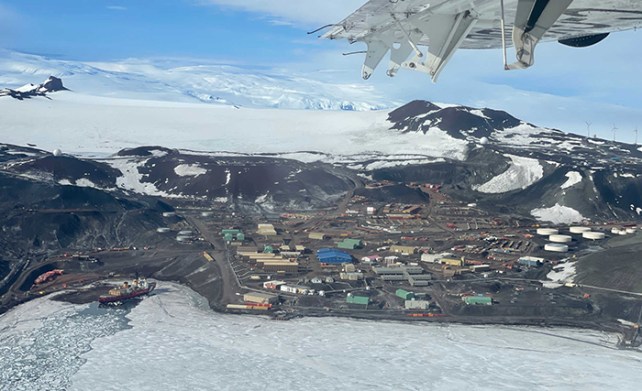
McMurdo Station—a village of dormitories, offices, warehouses, and a handful of bars—is the closest thing to a town on Antarctica. Its culture is complex and opaque, Pettit said, and some areas have a reputation of being dangerous for women, according to the NSF report.
Peter Neff/COLDEX
But Nash and Pettit think what’s clearly a systemic culture problem requires a more systemic response—and more of a focus on prevention, which the NSF report called “nearly absent.” The NSF response is far from the drastic intervention some researchers have called for.
One problem, they agree, is that researchers fail to think of Antarctica, and especially remote field camps, as workplaces like any other. “It’s stunning, because if some of the stuff happened in any other workplace that was not in Antarctica, it would never be allowed,” Nash said. “People still don’t see Antarctica as a workplace with workplace norms, and that the rules of Australia or the US actually apply when you’re out there.”
Ice core teams often consist of researchers and drilling staff from multiple institutions that just turn up on the ice and work and live together in camps 24/7. The teams have guidelines for field safety, but may not have codes of conduct. In a 2021 study Nash conducted, only three of 36 National Antarctic Programs’ expeditioner handbooks or field manuals mentioned sexual harassment.
“Programs should be seeing sexual harassment as a catastrophic risk to the organization,” Nash said, “treating it just like they would with any other legitimate safety issue that they cater for to manage risk around—like falling in a crevasse. Like all the things people get trained to survive in an extreme environment. Sexual harassment should be at the top of the list too, and it’s just not.”
She’s not confident the national polar program leadership will do much to help. In the NSF report, while almost 90 percent of senior leadership agreed that sexual harassment and assault are important to address, less than a quarter of them agreed that sexual assault was a problem in Antarctica.
Now that the Antarctic research season has finished, and Pettit is back home, she said she still sees room for improvement. Although the NSF provided bystander training and had a confidential advocate on station for people to talk to—support that Pettit said “is great in the moment or after the traumatic interaction”—she stressed that the real need is a change “from leadership at all levels.”
Pettit and other field team leaders, she added, “have limited impact if the rest of the leadership structure isn’t also acting to change the culture.”

